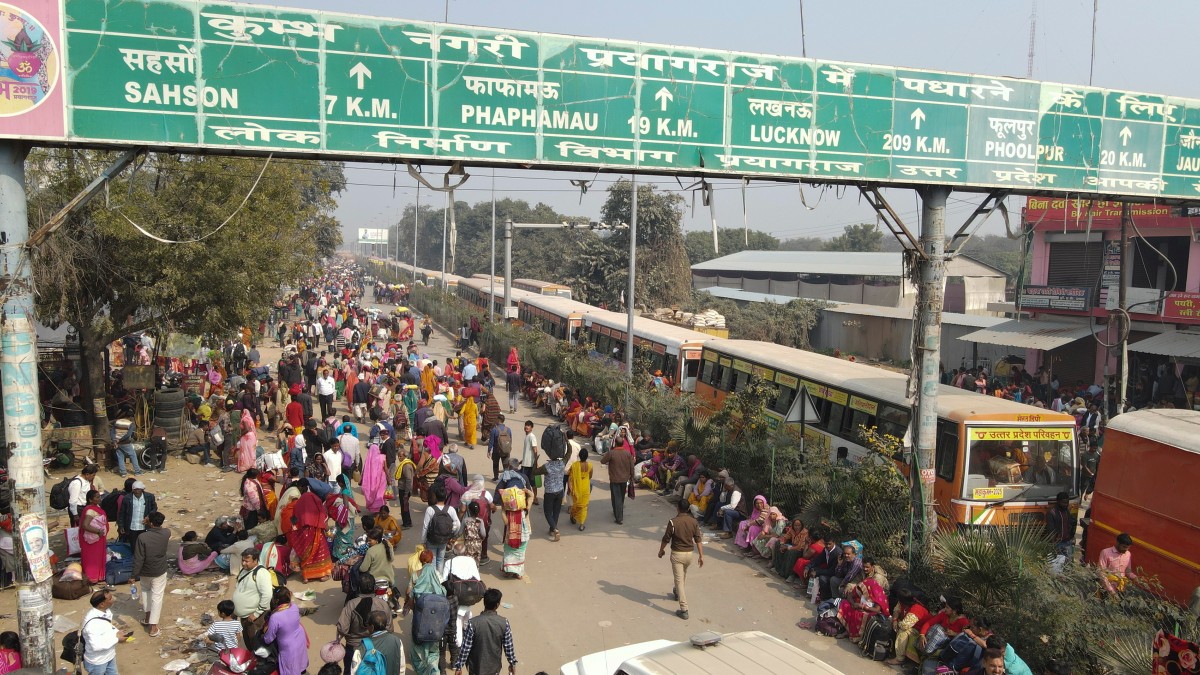The stampede at Maha Kumbh in Uttar Pradesh’s Prayagraj early Wednesday killed at least 30 people and injured 60 others.
In the wake of the tragedy , the state government introduced strict decongestion measures to prevent further such incidents.
As a result, a massive traffic jam and cancellation of trains have left thousands of pilgrims stranded in the spiritual epicentre without food, water, or shelter.
Let’s take a closer look.
Crowd decongestion plan
After the tragedy, the Uttar Pradesh police put seven emergency measures into action and sealed off the district’s borders to halt all vehicles from entering the Mela area starting late Wednesday evening.
News18 says that the team devised 32 crowd control plans that covered key locations such as bus terminals, train stations, and city limits.
“Due to the overwhelming crowd of devotees at the Mela, vehicle entry into the city limits was completely restricted. Additionally, seven emergency plans were implemented at various locations to manage the crowd effectively,” Neeraj Pandey, DCP Traffic, Maha Kumbh Nagar, told the channel.
The UP administration has implemented also cancelled VVIP passes, even for holders of special permits, to ensure no exceptions are made for vehicle access.
A one-way movement system has been implemented to control pilgrims’ foot traffic as they enter and exit the Sangam.
To avoid traffic jams inside the city, traffic from nearby districts including Pratapgarh, Kaushambi, Fatehpur, Chitrakoot, Jaunpur, and Mirzapur is also being stopped at entry points.
Until February 4, four-wheelers are not allowed to enter Prayagraj itself as officials strive to keep the area safe and orderly.
Stranded devotees and vehicles
But hundreds of pilgrims who travel from all over the nation have also found their plight made worse by these plans.
Thousands of devotees, including children, women, and the elderly, are stuck in massive traffic jams stretching for several kilometres on highways. People said that reaching Prayagraj is no less than a struggle.
At least two lakh pilgrims are stranded in a 25-kilometer traffic jam on the Chitrakoot-Prayagraj highway, with cars stopped at several checkpoints, including Bharatkoop, Rajapur, Mau, and Murgaha.
Due to a lack of accommodations, many people—including women and children—have been forced to spend the night outside.
A devotee from Karnataka named Sudha Chandran told News18 that the authorities were now requesting that she depart without taking the holy bath after she had already spent four days in a packed train.
Similar scenes have been witnessed on the Pratapgarh-Prayagraj route, the Varanasi-Prayagraj route, the Kaushambi-Prayagraj route, and the Rewa-Prayagraj route.
Every bus on the roads from Mirzapur to Prayagraj has been diverted. Many people have been forced to sleep by the side of the road as a result of the over 2,000 private cars that have been stopped at checkpoints.
Over 40,000 vehicles have been affected by 20 km of traffic congestion on the Varanasi-Prayagraj route. At least 200 buses were stranded.
In Kaushambi, more than 50,000 cars have been pulled over at different holding locations.
Many pilgrims are now forced to keep going their way on foot because major checkpoints at Babusarai, Gopiganj, and Bhadohi have been sealed.
Nearly 50,000 cars are stuck at the MP-UP border at Chaka Ghat, Rewa. To control the crowd, authorities have sent out 50 police officers and two DSPs.
Trains cancelled
The situation has gotten worse due to the cancellation of passenger trains from Jaunpur to Prayagraj, which has left scores of people stuck at train stations.
Major trains have been suspended, such as the Jaunpur-Bareilly and Allahabad-Prayagraj Passenger.
Bus terminals are crowded as buses were stopped at checkpoints for those attempting to travel by road to Prayagraj.
Kanpur-based devotee Vipin Sharma bemoaned the lack of prior communication, saying that pilgrims could have made other plans if they had been notified sooner.
‘A test of faith’
Brijesh Pratap Singh, a local, observed that pilgrims were becoming increasingly irritated despite efforts by authorities to supply food and drink.
The lack of sanitary facilities has made matters worse, particularly for women, despite attempts to erect temporary shelters at Mahesh Bhattacharya Inter College and other places.
Delhi pilgrim Shatrughan Kumar said he had already covered 18 kilometres and was not sure how much more he needed to do. He was travelling with his elderly mother, who was having difficulty walking.
Many tourists, including Geeta from Faridabad, expressed dissatisfaction at the lack of drinking water and restrooms along the road.
Authorities are giving the pilgrims free food, tea, and snacks, according to Traffic CO JP Pandey. However, they can only continue until Prayagraj traffic improves.
Most devotees continue to be faithful to their beliefs in spite of these challenges.
As Parag Mishra, an elderly devotee from Madhya Pradesh, told News18, “This is a test of faith. No matter what, we will take a dip in the holy Ganga."
The Maha Kumbh stampede
More than 30 individuals lost their lives and 60 were injured in the stampede at the Sangam in Prayagraj , Uttar Pradesh on Wednesday.
Large people flocked to the ghats for a holy dip on the occasion of Mauni Amavasya amid the ongoing Maha Kumbh.
UP Chief Minister Yogi Adityanath has directed a judicial committee to investigate the stampede tragedy and said that a second investigation would be conducted to examine police shortcomings.
Prime Minister Narendra Modi and Union Home Minister Amit Shah also called him up to assess the situation.
With inputs from agencies


)

)
)
)
)
)
)
)
)



